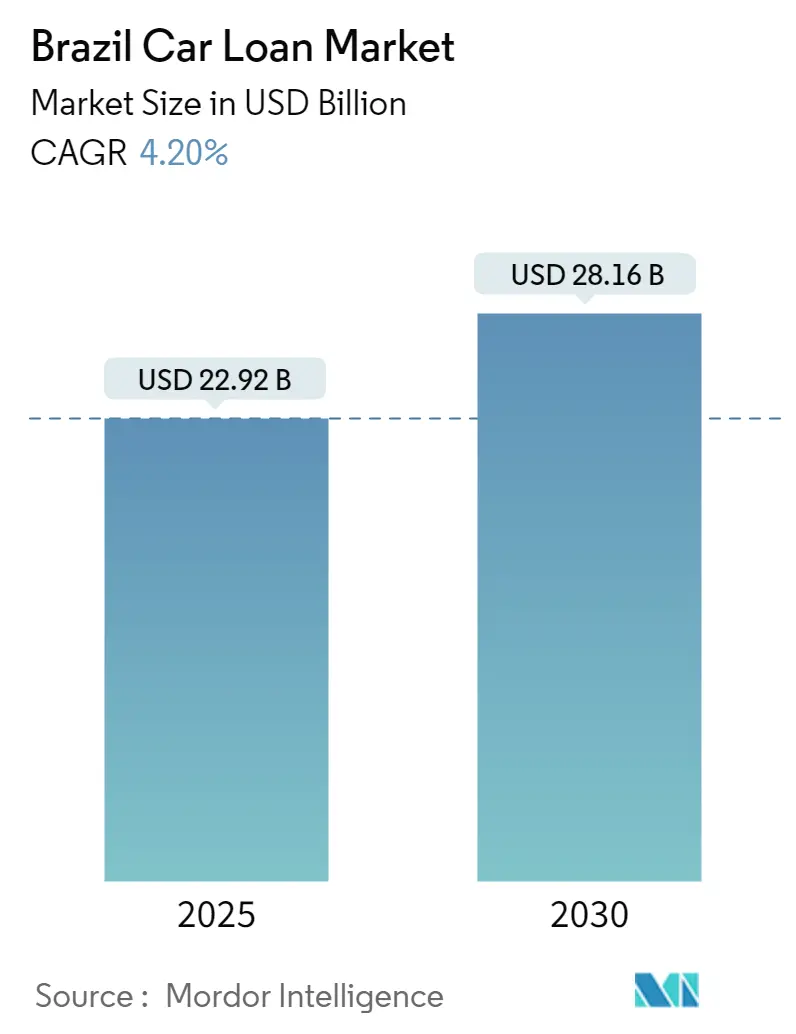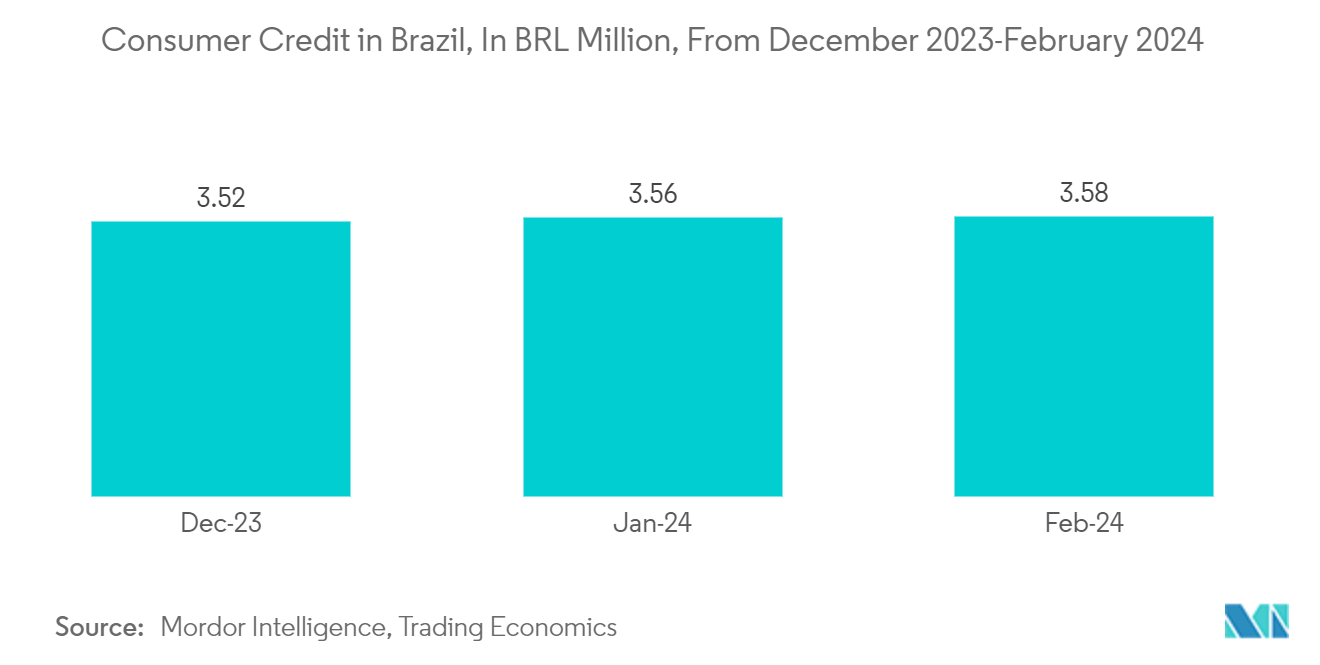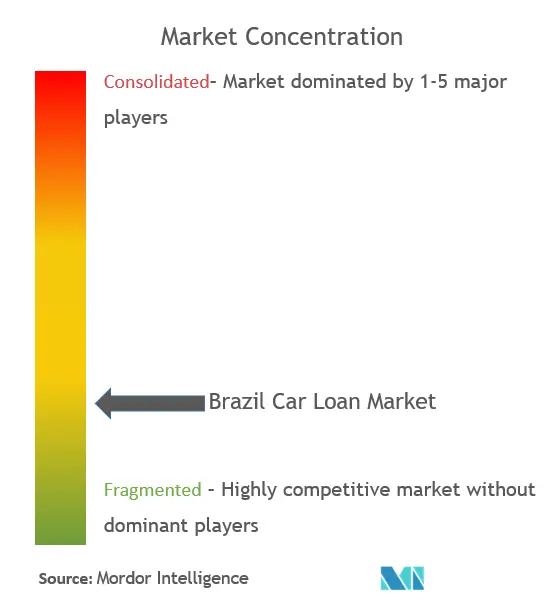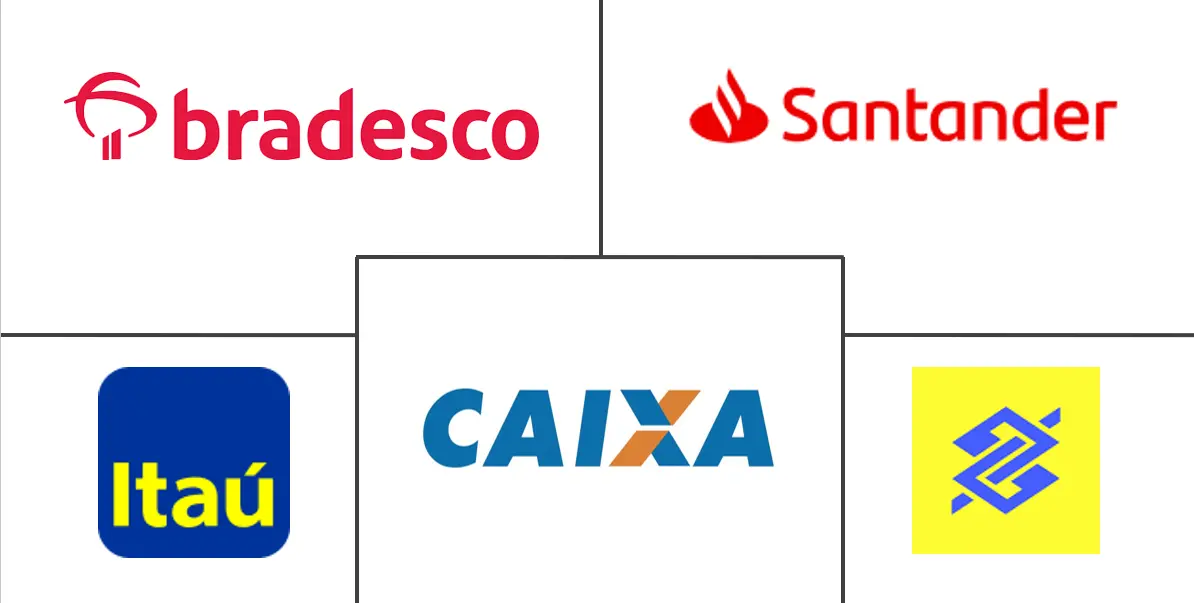Brazil Car Loan Market Size and Share

Brazil Car Loan Market Analysis by Mordor Intelligence
The Brazil Car Loan Market size is estimated at USD 22.92 billion in 2025, and is expected to reach USD 28.16 billion by 2030, at a CAGR of 4.2% during the forecast period (2025-2030).
The Brazil car loan market is poised for substantial growth in the forecast period, standing as a significant component of the nation's financial sector and playing a major role in the economy. Car loans are commonly employed by Brazilian consumers to finance both new and used vehicles, with various options available such as traditional loans, leasing, and dealership financing.
In Brazil, traditional loans and leasing options are typically provided by banks and financial institutions, while financing through car dealerships is commonly offered by automakers or specialized finance companies. The interest rates on car loans exhibit variability, the vehicle type, and the repayment term. Rates can range from approximately 1.5% to 3.5% per month, dependent on these factors. Repayment terms loan may vary from 12 to 72 months, with some lenders offering extended options, though longer terms may entail higher overall interest costs.
To further enhance the Brazil car loan market, recent market drivers and opportunities encompassing evolving financial technologies, changing consumer preferences, and government policies supporting automotive financing should be considered. Technological advancements have the potential to streamline loan processes, while adapting to changing consumer needs and aligning with supportive government initiatives can contribute to sustained market growth.
Brazil Car Loan Market Trends and Insights
Availability and Accessibility of Credit is Driving the Market
The availability and accessibility of credit played a significant role in driving the car loan market in Brazil. Over the years, Brazil witnessed the expansion of financial institutions and the development of credit infrastructure, making it easier for individuals to obtain car loans.
One key factor is the increased competition among banks and other financial institutions. As more players enter the market, they strive to attract customers by offering competitive interest rates, flexible repayment terms, and simplified application processes. This increased competition resulted in more accessible credit options for car loan consumers.
Brazil's growing middle class and rising disposable incomes created a greater demand for personal vehicles. As people aspire to own cars, credit availability provides them with the means to finance their purchases. Car loans allow individuals to spread the cost of buying a car over time, making it more affordable and manageable for a broader population segment.
The Brazilian government also implemented policies to stimulate car sales and support the automotive industry. Tax incentives and subsidized interest rates on car loans further encouraged consumers to purchase vehicles, boosting the demand for car loans.

Rise in Demand for Luxury Cars Fueling the Market Growth
The rise in demand for luxury cars contributed to Brazil's car loan market's growth. As the country's economy improved and the purchasing power of consumers increased, there was a noticeable shift towards luxury vehicles.
Luxury cars are often associated with higher price tags, making them less affordable for many buyers when purchasing outright. Car loans provide a solution by allowing individuals to finance the purchase of these high-end vehicles over time, making them more accessible to a broader range of consumers.
Financial institutions and car dealerships recognized this trend and tailored their offerings to cater to the luxury car market. They developed specialized loan programs and financing options for luxury vehicles, providing competitive interest rates and favorable terms to attract buyers.
Furthermore, luxury cars' allure, advanced features, cutting-edge technology, and prestigious branding fueled consumer aspirations. As more individuals aspire to own these luxury vehicles, the availability of car loans plays a vital role in turning those aspirations into reality.
It's worth noting that the demand for luxury cars is not limited to Brazil's major cities but also spread to emerging markets and regions across the country. This wider geographical reach further contributed to the growth of the car loan market as financial institutions extended their services to cater to the increasing demand.

Competitive Landscape
The market for Brazilian car loans is highly fragmented. Major players like Banco do Brasil, Caixa Economica Federal, Bradesco, Santander, and Itau Unibanco dominate the market. However, due to product innovation and technology developments, mid-sized and smaller businesses are growing their market share by winning new businesses and entering untapped sectors.
Brazil Car Loan Industry Leaders
-
Banco do Brasil
-
Caixa Economica Federal
-
Bradesco
-
Santander
-
Itau Unibanco
- *Disclaimer: Major Players sorted in no particular order

Recent Industry Developments
- In July 2023, A strategic agreement has been announced by Pluxee (Sodexo Benefits & Rewards Services) and Santander Brazil, one of the biggest private banks in the nation, to strengthen Pluxee's market leadership in Brazil.
- In August 2023, Livelo, one of the leading rewards companies in Brazil launched a partnership, Banco PAN. The PAN Mais loyalty programs over 300,000 members can now transfer their points to Livelo thanks to this new functionality.
Brazil Car Loan Market Report Scope
A car loan, also known as an auto or vehicle loan, is financing provided by a financial institution or lender to help individuals purchase a car. A complete background analysis of the brazil car loan market includes an assessment of the industry associations, the overall economy, and emerging market trends by segment. Significant changes in the market dynamics and market overview are also covered in the report.
The Brazilian car loan market is segmented by product type and provider type. By product type, the market is sub-segmented into used cars (consumer use & business use) and new cars (consumer use & business use). By provider types, the market is sub-segmented into banks, non-banking financial services, original equipment manufacturers, and others (fintech companies). The report offers the value (USD) for the above segments.
| Used Cars (Consumer Use & Business Use) |
| New Cars (Consumer Use & Business Use) |
| Banks |
| Non-Banking Financial Services |
| Original Equipment Manufacturers |
| Others (Fintech Companies) |
| By Product Type | Used Cars (Consumer Use & Business Use) |
| New Cars (Consumer Use & Business Use) | |
| By Provider Type | Banks |
| Non-Banking Financial Services | |
| Original Equipment Manufacturers | |
| Others (Fintech Companies) |
Key Questions Answered in the Report
How big is the Brazil Car Loan Market?
The Brazil Car Loan Market size is expected to reach USD 22.92 billion in 2025 and grow at a CAGR of 4.20% to reach USD 28.16 billion by 2030.
What is the current Brazil Car Loan Market size?
In 2025, the Brazil Car Loan Market size is expected to reach USD 22.92 billion.
Who are the key players in Brazil Car Loan Market?
Banco do Brasil, Caixa Economica Federal, Bradesco, Santander and Itau Unibanco are the major companies operating in the Brazil Car Loan Market.
What years does this Brazil Car Loan Market cover, and what was the market size in 2024?
In 2024, the Brazil Car Loan Market size was estimated at USD 21.96 billion. The report covers the Brazil Car Loan Market historical market size for years: 2020, 2021, 2022, 2023 and 2024. The report also forecasts the Brazil Car Loan Market size for years: 2025, 2026, 2027, 2028, 2029 and 2030.
Page last updated on:
Brazil Car Loan Market Report
Statistics for the 2025 Brazil Car Loan market share, size and revenue growth rate, created by Mordor Intelligence™ Industry Reports. Brazil Car Loan analysis includes a market forecast outlook for 2025 to 2030 and historical overview. Get a sample of this industry analysis as a free report PDF download.



